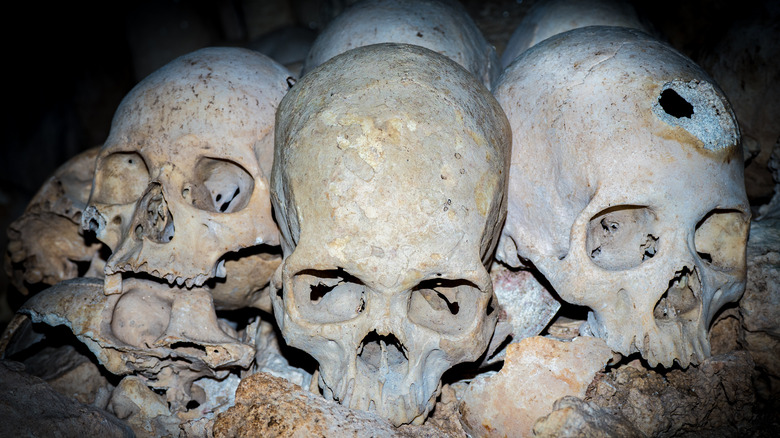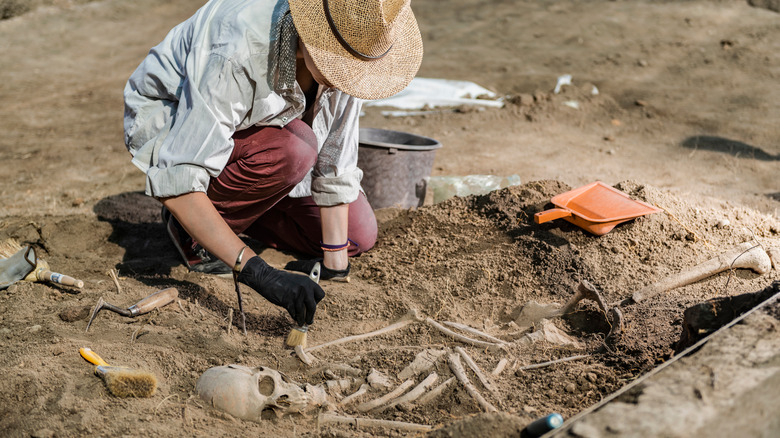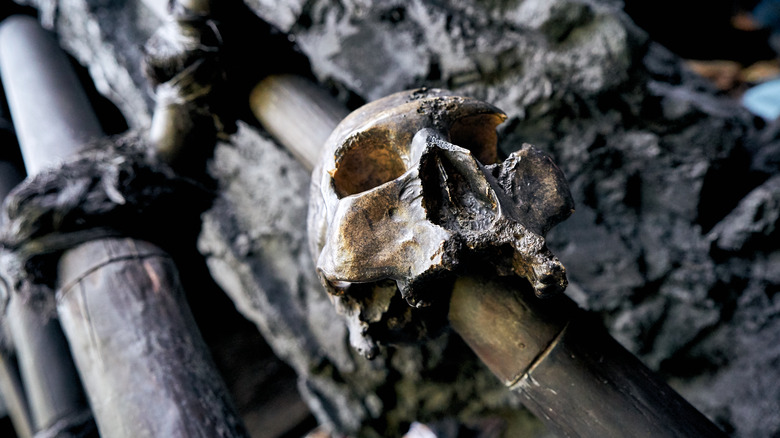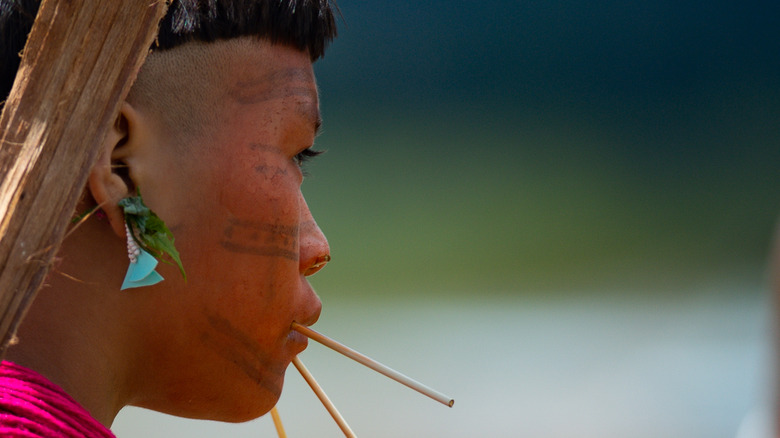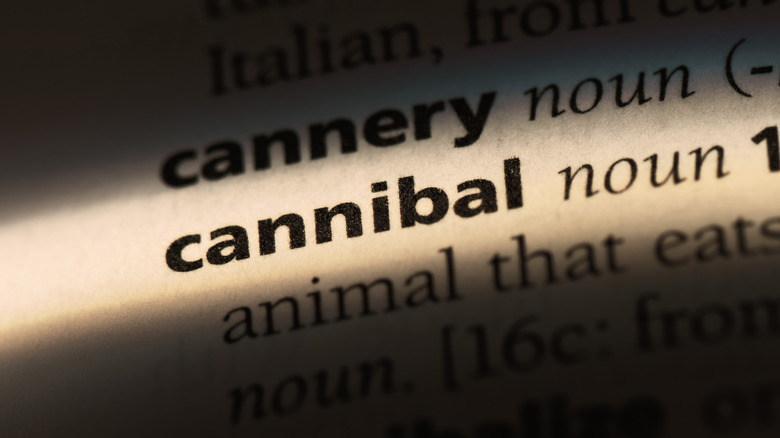Endocannibalism: The Ritual Of Consuming Your Dead Loved Ones
The idea of cannibalism (or anthropophagy, its clinical name) might be shocking in modern times, but the practice has been around for centuries. According to HowStuffWorks, cannibalism (the practice of humans eating the flesh or organs of other humans) can be generally divided into two categories: survival and learned.
Survival cannibalism is usually the result of being thrown in an extreme situation and more common than we'd like to admit in modern times. It happens as a last resort, in cases where cannibalism is the only way to survive. In 1846, a group of 87 men, women and children pioneers heading towards California — the Donner Party — got trapped in snow before reaching their destination. To survive the winter, they ate the bodies of those who died due to disease and starvation. By the time the group was rescued four months later, only 46 people were still alive (via PBS). Another famous example happened a lot more recently. In 1972, survivors of a plane crash in the Andes resorted to cannibalism to survive 70 days in the mountains (via HowStuffWorks).
Learned cannibalism is the more ancient form of cannibalism and a relatively common practice among many indigenous tribes around the world. Britannica points out signs of cannibalism have been found among the Maoris in New Zealand, several tribes in Africa, South American tribes, and some islands in Fiji and Polynesia. This type of cannibalism has many reasons, from ritualistic practices to funeral rites to a way of acquiring an enemy's power after their death.
So what about endocannibalism?
Learned cannibalism is further divided into two subgroups: Exocannibalism and endocannibalism (per HowStuffWorks).
Exocannibalism is an aggressive act, done to cause fear or as an act of revenge. In some tribes, it was common practice to eat enemies killed in combat. According to Alimentarium, this could be done as an act of revenge or simply to inspire fear and deter others from attacking. In some tribes, eating your enemy would be done in hopes of also "eating their strength." For example, the Aztecs used cannibalism along with ritual sacrifice, and headhunters would often eat their enemies before taking their heads to protect themselves against spirit revenge (via HowStuffWorks).
Endocannibalism is the exact opposite. According to HowStuffWorks, endocannibalism is the consumption of the flesh of a person somewhat close to you. This could be as close as a family member but could also be a member of your tribe or community. But the main difference with endocannibalism is that it's usually a loving act. It's done as a sign of respect or veneration of the dead or as a spiritual pursuit. For example, the Fore peoples of Papua New Guinea would eat their dead before putting them to their final rest, while the Amazon's Wari' would eat their loved ones as a way of dealing with their grief.
Other reasons for endocannibalism
In many societies, endocannibalism had either a religious or a magical meaning. For example, endocannibalism could be a way to keep the deceased alive or honor ancestors. According to Alimentarium, consuming a loved one will keep carry on this person's spirit among the living. When the Wari' people ate their family members after death, they were hoping to release their spirits, which could then inhabit an animal and become nourishment for others (per HowStuffWorks).
Many isolated tribes practice mortuary cannibalism, a form of endocannibalism that allows the consumption of human flesh (or other body parts) only as part of a funerary ritual. The Wari' actually had very involved mortuary preparations that involved holding the body until relatives arrive (often 2-3 days), then roasted the flesh over a fire and invited others to eat it (via Sapiens).
The act of consuming the dead would help the family understand the body was now empty (the spirit no longer there) and consuming it was the first step to make the pain and grief disappear as the body itself disappeared. Even the eating process itself would reflect this pain, as the flesh would be eaten in a delicate, gentle way using tools, rather than in the way you would eat game you hunted, according to Sapiens.
Endocannibalism doesn't always look the same
Endocannibalism doesn't always involve eating flesh. In some cases, tribe members might consume the bones or just certain parts of the body, like the heart. A good example of this comes from the Yanomami tribe in South America, where consuming the dead is done as a replacement for a burial (via The Guardian).
But the Yanomami don't eat the flesh of their dead. Instead, they burn the bodies. After that, ashes are used to paint their faces and the burned bones are ground up and mixed with ashes to be consumed. This mixture is then added to mashed bananas and made into a soup. As they see it, consuming the final mix is the only way to guarantee the dead will be able to rest properly.
Scientists believe that Neanderthals might have practiced endocannibalism as well. Studies of the Krapina excavation site in Croatia show a mix of human and animal bones that appear to have been part of a mortuary practice involving cannibalism. In particular, anthropologists have found evidence of marrow and brain extraction that could indicate Neanderthals consumed parts of their dead (per Periodicum Biologorum, posted at ResearchGate).
The medical risks of endocannibalism
A very rare disease called kuru (or prion disease) is uniquely associated with cannibalism. It's so rare that it's mostly exclusively to the Fore people in Papua New Guinea. Kuru is a nervous system disease caused by eating or coming in contact with contaminated human brain tissue. It belongs to the a group of diseases known as transmissible spongiform encephalopathies (TSEs), in the same family as mad cow disease (via National Institute of Neurological Disorders and Stroke).
The Fore people consumed their loved dead ones (including their brains) during funeral rituals, and would contract the disease easily in the process. Because Kuru has a very long incubation period — it averages a decade, but can be as long as 50 years — even anthropologists couldn't understand at first how the disease was transmitted. There's no treatment and no cure for kuru, and those infected will usually die within a year of showing symptoms, which include difficulty walking, malnutrition, and swallowing difficulty before the person goes into a coma (per MedlinePlus).
But consuming the dead is not just something that only happened in small tribes in faraway islands. In the 16th and 17th century, cannibalism-based medicine was actually quite common in Europe. Plenty of remedies were made using ground-up mummies, powdered skulls, and human fat, often to the detriment of the health of patients, who would've been much better helped by using herbs or whatever other treatments were available at the time (via Smithsonian Magazine).
Cannibalism in modern times
Most cases of cannibalism in modern times have been either cases of survival cannibalism or exocannibalism. In the early 1930s, Joseph Stalin's policies caused a widespread famine in Ukraine that lead to the starvation of millions and caused many to turn to cannibalism to survive (per The Washington Post). And around the world, many serial killers have spread horror by also eating their victims; Jeffrey Dahmer murdered and ate 17 young men before he was captured (via The Sun).
In 2012, members of a cannibal cult were arrested in Papua New Guinea after killing and consuming seven people (per the New Zealand Herald). And in India, followers of the Aghori sect take bodies from the Ganges River to engage in cannibalistic rituals that they believe would grant them special powers (per a report by "Today" on the documentary "Feeding on the Dead," posted on YouTube). Cannibalism has also been used recently as a weapon of war. During the civil war in Congo, soldier and rebels would kill enemies and kill and then eat their victims (via a 2003 report by The New York Times).
Perhaps the most rare form of cannibalism is self-cannibalism, when people cut themselves to ingest parts of their bodies. Self-cannibalism is often associated with mental illness, including personality and acute and chronic psychotic disorders. In a case reported in 2014, a male prisoner was brought to the emergency room after cutting a portion of his leg and eating it. He was treated and then returned to the prison (as reported on the Western Journal of Emergency Medicine: Integrating Emergency Care with Population Health, posted at eScholarship).
